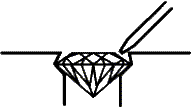पुखराज- येल्लो सफायर
पुखराज, ज्यूपिटर की द्रष्टि नम्र करने लिए पहना जाता है । Sagittarius और pisces के महीनो में पैदा हुए लोगों को इस पीले पत्थर के पहने से आम तौर से ज्यादा फायदा होता है । माना जाता है की पुखराज पहनने वाले को मन की शान्ति, धन की प्राप्ती, अच्छी सेहत, अक्ल, लम्बी उम्र, नाम, शोहरत और सहनशीलता प्राप्त होती है ।
पत्थर की पहचान
कोरुन्दुम नाम की वराईटी के पीले रंग के पत्थर को पुखराज या फिर येल्लो सफायर कहते हैं। क्योंकी इस सुनहरे से पत्थर की कीमत काफी ज्यादा होती है, इसी लिए, बाज़ार में कई पीले पत्थर पुखराज के नाम से बेचे जाते हैं। आम तौर पर इस पत्थर की पहचान करना काफ़ी कठिन है, परंतू यदी आप कुछ सरल उपाय लगाये तो कुछ हद तक आप सही पत्थर खरीद सकते हैं।
पत्थर की पहचान
कोरुन्दुम नाम की वराईटी के पीले रंग के पत्थर को पुखराज या फिर येल्लो सफायर कहते हैं। क्योंकी इस सुनहरे से पत्थर की कीमत काफी ज्यादा होती है, इसी लिए, बाज़ार में कई पीले पत्थर पुखराज के नाम से बेचे जाते हैं। आम तौर पर इस पत्थर की पहचान करना काफ़ी कठिन है, परंतू यदी आप कुछ सरल उपाय लगाये तो कुछ हद तक आप सही पत्थर खरीद सकते हैं।
- पुखराज महंगा पत्थर होता है, तो सबसे पहले आप गौर कीजिये इसकी कीमत पर। अगर कीमत कुछ ज्यादा ही ख़ास है, तो और ध्यान दीजिये की आप क्या खरीद रहे हैं।
- पत्थर का रंग पीला होता है, जिसमें हरा रंग कतई नही होता। इसका पीलापन जितना गहरा होगा, उतना ही ये महंगा होता जाएगा।








